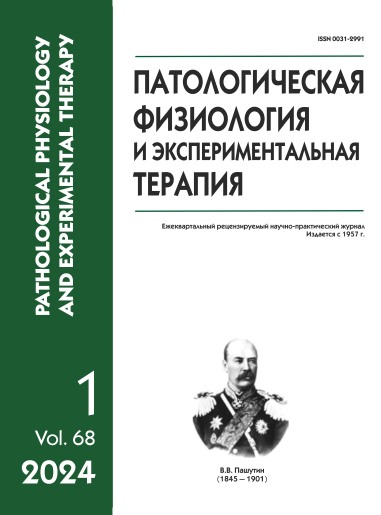Morphological and functional changes in the nervous tissue of the cerebral cortex in forced anaerobic exercise and after acupuncture injection of allogeneic biomaterial (experimental study)
Abstract
Introduction. Forced physical activity often disrupts the interactions between the cerebral cortex and internal organs. Allogeneic biomaterial (BMA) is used as a regeneration stimulator when applied topically. The mechanism of pharmacopuncture correction of pathological changes in the neocortex with BMA is not well understood.
Aim. To study the structure of nervous tissue in the cerebral cortex after acupuncture of biologically active points and pharmacopuncture administration of BMA.
Methods. Anaerobic physical activity was modeled by forced swimming of male rats with a load of 10% of body weight. After the swimming test, in the experimental group (n=20), a BMA suspension was administered by acupuncture. In the control group (n=20), saline was administered. Five and 21 days following the forced anaerobic exercise, tissue was sampled, and morpho-functional studies were performed.
Results. In the control group, reactive gliosis, edema of the neuropil, perinuclear and perivascular spaces, reduction of the synaptic apparatus, increased chromatolysis of neurocytes, and a decrease in the apoptosis inhibitor Bcl-2+ in cells were found. In the experimental group, there were signs of restoration of the architectonics of the layers of neocortical nerve cells, an increase in the number of synapses, microglial cells (CD-68+), cell Bcl-2+, a decrease in the number of shadow cells and cell GFAP+, and restoration of the neurovascular unit that ensures the blood-brain barrier functioning.
Conclusion. In the brain of control rats, irreversible destructive changes prevailed. Acupuncture of BMA stimulated neuroprotection.
Downloads
References
1. Gordon NF. Chronic fatigue and physical activity. K.: Olimpijskaya literatura. 1999: 126 p. (in Russian)
2. Cabýoglu MT, Ergene N, Tan U. The mechanism of acupuncture and clinical applications. Int J Neurosci. 2006.116(2):115-25. doi: 10.1080/00207450500341472.].
3. Krotkova OS. Luminescent-morphological characteristics of the spleen of rats in different rats at different time periods after acupuncture. Sovremennye naukoemkie tekhnologii. 2009; 11:128-136. (in Russian)
4. Han J.S. Acupuncture and endorphins. Neurosci Lett. 2004; 6;361(1-3):258-261. doi: 10.1016/j.neulet.2003.12.019
5. Muldashev ER, Muslimov SA, Galimova VU. Biological bases for the use of Alloplant biomaterials in regenerative surgery in the book. Alloplant® Regenerative medicine. Ed. E.R. Muldashev. Ufa: State Unitary Enterprise «Gosudarstvennoe respublikanskoe izdatel'stvo «Bashkortostan». 2014: 30-42. (in Russian)
6. Muldashev ER, Galimova VU, Galiakhmetov RF. Morphological aspects of pharmacopuncture using biomaterials. Morfologicheskie vedomosti. 2007; 3-4: 128-130. (in Russian)
7. Aprelev AE. Efficiency of using pharmacopuncture with Alloplant biomaterial in the complex treatment of patients with myopia in the long-term period. Sovremennaya optometriya. 2011; 2 (42): 12-14. (in Russian)
8. Mirkhaydarov RSh. Experience in the use of alloplant biomaterial in chronic viral hepatitis C at the outpatient stage of rehabilitation. Voprosy kurortologii, fizioterapii i lechebnoj fizicheskoj kul'tury. 2021; 98(3-2): 126-127. (in Russian)
9. Porsolt RD, Anton G, Blavet N. еt al. Behavioral despair in rats: a new model sensitive to antidepressant treatment. Europ. J. Pharmacol. 1978; 47:379-391.
10. Volchegorsky NA et al. Patent for invention No. 261706 dated April 21, 2017(in Russian)
11. Karkishchenko VN, Kapanadze GD, Denginina SE, Stankova NV. Development of a methodology for assessing the physical endurance of small laboratory animals to study the adaptogenic activity of certain drugs. Biomedicina. 2011; 1:72–74. (in Russian)
12. Belousov PV. Acupuncture points of Chinese Zhenjiu therapy. Almaty, 2004: 448 p. ISBN 9965-9452-5-X. (in Russian)
13. Rebrova OYu. Statistical analysis of medical data. Application of the application package STATISTICA. Moscow: Media Sphere. 2002: 312 (in Russian)
14. Peters A, Paley S, Webster G. Ultrastructure of the nervous system. Moscow: Mir 1972: 176 p. (in Russian)
15. Eng LF, Ghirnikar RS, Lee YL. Glial fibrillary acidic protein: GFAP-thirty-one years (1969–2000) Neurochem Res. 2000; 25(9–10):1439–1451.
16. Gorbacheva LR, Pomytkin IA, Surin AM. Astrocytes and their role in the pathology of the central nervous system. Rossijskij pediatricheskij zhurnal. 2018; 21(1): 46-53. DOI: http://dx.doi. org/10.18821/1560-9561-2018-21-1-46-53. (in Russian)
17. Sofroniew M.V. Astrogliosis. Cold Spring Harb Perspect Biol. 2015; 7(2): a020420. doi: 10.1101/cshperspect.a020420
18. Sofroniew MV, Vinters HV. Astrocytes: biology and pathology. Acta Neuropathol. 2010; 119: 7–35.
19. Tsujimoto Y, Finger LR, Yunis J. et. al. Cloning of the chromosome breakpoint of neoplastic B cells with the t(14;18) chromosome translocation. Science 1984; 226: 1097–1099.
20. Cleary ML, Smith SD, Sklar J. Cloning and structural analysis of cDNAs for bcl-2 and a hybrid bcl-2/immunoglobulin transcript resulting from the t(14;18) translocation. Cell. 1986; 47: 19–28.
21. Lindsten T, Zong WX, Thompson CB. Defining the role of the Bcl-2 family of proteins in the nervous system. Neuroscientist. 2005; 11(1):10-15. doi: 10.1177/1073858404269267.
22. Sinyakin IA, Batalova TA. Microglia as a key component in the regulation of synaptic activity. Scientific review. Biological Sciences. 2020; 4:53-58. (in Russ.)
23. Alekseeva OS, Kirik OV., Gilerovich EG., Korzhevsky DE. Brain microglia: origin, structure and functions. Zhurnal evolyucionnoj biohimii i fiziologii. 2019; 55(4): 231–241. (in Russian)
24. Lebedeva AI, Muslimov SA, Afanasiev SA, Kondratieva DS. The role of macrophages in the regeneration of muscle tissues induced by allogeneic biomaterial. Rossijskij immunologicheskij zhurnal. 2019; 13(22): 849-851. (in Russian)
25. Sudakov KV. General theory of functional systems. M.: Medicine. 1984: 224p. (in Russian)
26. Zilov VG, Sudakov KV, Epstein OI. Elements of information biology and medicine. Moscow: MGUL; 2000: 248p. (in Russian)






